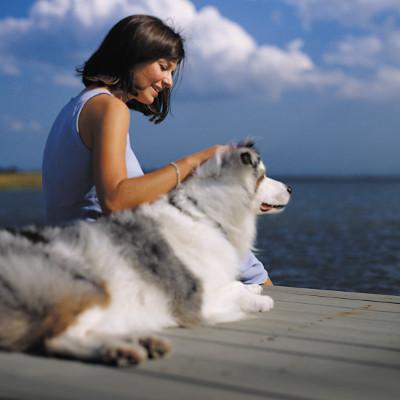Guest post from Dr. Patrick Mahaney, VMD
Dr Mahaney and his dog Cardiff (photo credit: ilovedogs.com)
When is your cat, dog, or other companion animal considered a senior? There is no single answer applying to every pet, yet I consider seven to nine years of age as the threshold to senior living. When following the notion that pets age seven years for every one human year, a seven to nine year old pet falls between the ages of 49 to 63. Some pets show physical signs of aging earlier in life due to genetics, nutrition, environment, and disease.
Others sail gracefully from adulthood into their elderly years with minimal apparent decline in youthful vigor. Mother nature invariably wins, as the body’s regenerative and infection-fighting abilities wane with time. What is the secret to maintaining the health of your senior pet? Healthy pets, regardless of age, rely on the efforts the pet guardian (you), veterinary medical care providers, and good fortune. Here are my top senior pet health tips:
Schedule Regular Veterinary Physical Examinations Senior pets are prone to periodontal disease, arthritis, cancer and ailments affecting the kidneys, liver, and endocrine system (adrenal and thyroid glands, etc). Manifestations of these diseases can be subtle or only arise when severe and potentially irreversible changes have occurred. In managing such conditions, your senior pet should have a physical exam performed by a veterinarian at least every 12 months.
Disease afflicted pets should be examined every 3-6 months, or more frequently. Your vet’s exam may discern problems that otherwise would go unnoticed to the untrained eye or hand. Provide your veterinarian with daily observations of your pet’s food and water consumption, bowel movement and urinary habits, vomiting, diarrhea, coughing, sneezing, and sleep and energetic patterns. Additionally, keep record of any supplements, medications, Chinese herbs, or other products regularly used.
Immediately Address Health Concerns When your pet’s shows signs of illness or if your veterinarian discovers an abnormality, pledge to efficiently resolve the issue. Periodontal disease (unhealthy teeth, gums, etc) is one of the most common diseases I see in clinical practice. I am astounded when pet owners address periodontal disease only after oral malodor, lethargy, inappetence, tooth abscesses, or internal organ (heart, lung, kidney, liver, other) damage are evident.
Take proactive steps to prevent periodontal disease from occurring. Brush teeth on a daily basis and provide appropriate objects on which your pet can chew to reduce accumulation of plaque and tartar. In cases where preventative measures are insufficient, pursuing an anesthetized dental is the most thorough means addressing periodontal disease. Although non-anesthetic dental (NAD) cleaning can remove visible accumulation, scaling under the gumline, tooth extraction, or evaluation via radiography (xrays) are impossible without anesthesia.
NAD also leaves the airway (trachea) susceptible to bacteria aerosolized during scaling. A senior pet is never “too old to undergo anesthesia”, yet “too unhealthy” is certainly possible. Routine senior wellness protocols, such as diagnostic testing and resolution of underling infection or inflammation, can ensure your pet has a routine anesthetic procedure and recovery.
Perform Routine Diagnostic Testing Although a pet’s history and physical exam yield much information, diagnostic testing offers a more accurate representation of overall health. Blood, urine, and fecal testing, radiographs (xrays), ultrasound, and other means help to best direct treatment. I recommend senior pets have baseline blood, urine, and fecal testing at least every 12 months. A minimum database of blood testing and ECG (electrocardiogram), and other case dependent diagnostics should be performed within 24 hours of a planned anesthetic procedure. The true value of diagnostics lie in early disease detection and treatment.
Provide a Whole Food Diet There is an unfortunate trend where sick or geriatric pets are put on a whole food diet only when given a serious diagnosis or when chewing a commercially available dry food becomes too painful (a preventable side effect of periodontal disease). My holistic veterinary practice strives to educate pet owners on the benefits of feeding minimally processed nutrients instead of heavily denatured dry and canned foods. In feeding appropriate quantities of whole food sources during juvenile and adult life stages, obesity, arthritis, and diabetes are less likely to occur during a pet’s senior years.
Tailor Your Pet’s Environment and Lifestyle to Suit Geriatric Needs As nubile puppies and kittens inevitably age, their ability to navigate the environment through which they once gracefully strode is also compromised. Slippery floors, steep stairs, lofty sleeping quarters, and extremes of heat, cold, dryness, and humidity are a hazardous to elderly pets. Enhance your home and yard environment to appropriately suit your senior pet and reduce the likelihood of preventable illness or injury. In conclusion, you are your pet’s primary health advocate during juvenile, adult, or senior life stages. Take an educated and proactive stance in promoting the best possible quality of life regardless of their age.
ABOUT DR MAHANEY Veterinarian Patrick Mahaney became interested in the integrative approach to medicine after suffering a series of back injuries. His chronic discomfort is now under control through a multimodal approach to pain management, including dietary modification and supplements, acupuncture, chiropractic, and (as needed) Western medication. Since his back condition is commonly seen in both dogs and cats, he feel a true connection to many of his patients’ problems.
Through California Pet Acupuncture & Wellness (CPAW), Inc., he provides a combination of Traditional Chinese Veterinary Medicine (TCVM) and Western veterinary services to improve his patients’ health. TCVM (Eastern) evaluates a patient’s physical manifestation of energetic movement along pathways (meridians) to direct treatment, such as acupuncture, musculoskeletal therapy, dietary modification, and Chinese herbs. Using both Eastern and Western perspectives, he takes a holistic approach to his patients’ health. This holistic approach strives to achieve a high quality of life for his patients from the sum of healthy individual organ systems. Visit his site at http://www.patrickmahaney.com/ or read his always interesting blog at http://www.patrickmahaney.com/blog/


